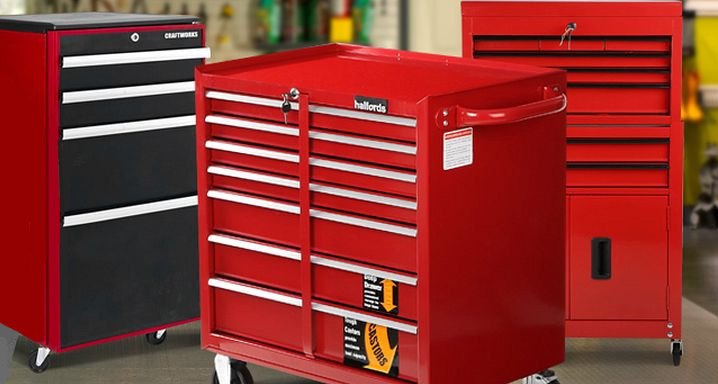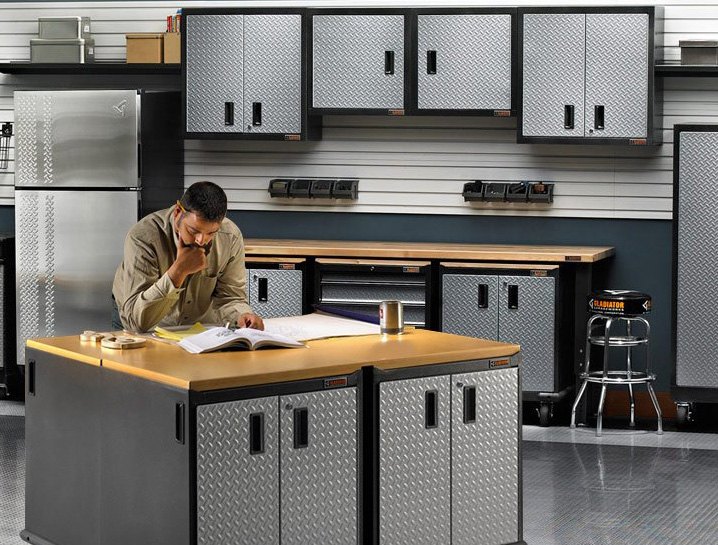
Tool boxes represent a great unappreciated necessity for your workshop or garage. As your mechanical skill grows, so does your need to purchase good quality tools. As your abilities continue to advance, you realize that a greater variety of tools helps you get jobs done more efficiently. So your tool collection expands, which is great. But piling your tools on your workbench, or in various portable carriers, or on shelves in scattered locations, just doesn't cut it any longer.
Perhaps this scenario rings a bell: You're in the middle of a rather complex job on your car. A major component is partially disassembled, and it's precariously perched, waiting for you to loosen and remove the few final bolts holding it in place. You have it gingerly leaning against the fender, and you need to walk away from it for a moment, because in order to continue its removal, you need a particular tool. You need that tool RIGHT NOW, and you CAN'T FIND IT. Frustrating, we know, we were there once! If you had all your tools organized in a decent tool box, this nightmare wouldn't exist. When you are ready to make this better for yourself, stop what you're doing, pour yourself a cold drink, and look through our selection of tool boxes, chests, and cabinets. We're here to help you decide which and how many of these important organizers you need.
The scope of this article will be focused on what are referred to as professional-level or mechanics-level tool boxes: tool chests, roller cabinets, or the combination of the two (see definitions below). While you can certainly consider portable tool boxes, rolling tool carts, locker cabinets, and small organizers, these are outside of today's discussion. We will zoom in on the all-metal, multi-drawer type of boxes that you see in dealership service departments and well-organized workshops.
Professional-Level And Mechanics-Level Tool Boxes
All these tool boxes have the amazing ability to hold a tremendous number of tools; they also can handle the tools' significant weight. Most tool box manufacturers specify the amount of weight each drawer can handle in pounds. You'll find units that can handle anywhere from 75 to several hundred pounds per drawer. As a general observation, you'll also note that the quality tool boxes we sell are not 'cheap'. The adage "you get what you pay for" is particularly apt when it comes to professional-quality tool boxes. This is not an area where you want to skimp. Strong, quality steel construction, with drawers that open and close easily, are features which tell you these boxes will put up with abuse for decades. You do NOT want to load up your new box, only to pull open a drawer that slides all the way out, dumping 50 pounds of wrenches onto your toes. Or worse, you discover that some drawers have actually bent under the combined weight of their load and no longer slide open. Think of a high-quality toolbox as a life-long investment.
Tool Box Types
Let's define tool box types as the industry does, and as you'll find them defined on our website:

- "Tool Chest", also called a "Top Box": a multi-drawer tool cabinet, designed to work either as a stand-alone tool box, OR, sit on top of a Roller Cabinet. Note that because of their size, "Tool Chests" are designed to sit at least waist-high. If used alone, they should be sitting on a workbench or table. They typically do not come with wheels. An example is the Extreme Tools 26" Tool Chest.
- "Roller Cabinet", also called a "Bottom Box": a multi-drawer tool cabinet, designed to work either as a stand-alone tool box, OR, serve as the base for a Tool Chest. Roller Cabinets typically include caster wheels (note the word "roller" in the name) and therefore are designed to sit on the floor. One example is the Homak 41" SE Series Roller Cabinet.
- "Combination Box", also called "Combo Box" or "Combo Unit": a combination of a Tool Chest (top box) and Roller Cabinet (bottom box). Sometimes these are sold as a unit so that the user has boxes from the same manufacturer which are assured to fit well together. A great example is this Extreme Tools 56" Top Chest and Roller Cabinet Combo. We can create a combo by selecting both the Homak 41" 8 Drawer Top Chest, and this Homak 41" 11 Drawer Roller Cabinet.
- "Side Cabinet": A tool box not designed to be used by itself, a Side Cabinet hangs or is installed on the side of a Roller Cabinet to increase its capacity. This Homak 17" 7 Drawer Side Cabinet is available in blue, black, or red, to match your existing box.
- "Pit Box": similar to a Roller Cabinet, a Pit Box features larger wheels, and an outsized handle with which to pull the unit. Some loaded Pit Boxes are so heavy that they must be pulled by a small tractor. Pit Boxes are used by race teams who need a greater ability for the box to be moved from location to location, occasionally over less-than-smooth terrain. This Extreme Tools 70" 9 Drawer Pit Box is as heavy-duty as you'll need.
When you're ready to make a purchase, the initial factors to consider are 1) the amount of needed storage, based on present and future tool ownership; and 2) the available space in your desired location. Let's tackle storage needs first. Make a serious assessment of your current tool inventory. Do you have what you need at present, or do you envision additional purchases in the near term? Have you been holding off buying tools, waiting for a good tool box to be in place first? At a minimum, you want to buy boxes that will hold what you have now, and that will give you some headway for future expansion. At the same time, should you need more space down the road, add-on units can also be considered.

Where are you going to put the boxes? Garage? Basement? Presuming that you are looking at either a Roller Cabinet or a Combo Unit, measure the WIDTH of the space. You'll find bottom boxes listed by width: 26", 41", and 56" are typical. Two further points here: try to fill the width you have, as you will gain a good amount of storage; and remember that the top box can be the same width or smaller, but not wider! Maximizing the width also keeps the overall height to a reasonable number. While you may have room up to the ceiling, you don't want to employ a stepladder every time you need a certain wrench!
You may be first drawn to boxes with "large" (that is, deep) drawers. While you will need some larger drawers to store bulky power tools, it is a fact that the vast majority of mechanics' tools are small hand tools: screwdrivers, wrenches, sockets, pliers, hammers, and the like. We find much greater versatility in having a larger number of shallow drawers rather than a smaller number of deeper drawers. You also want some of these drawers to be the same width as the box itself, to accommodate extra long screwdrivers, extension bars, pry bars, etc.

If you're starting small, you may be considering just a top chest or a roller cabinet as a stand-alone. Remember that the top chest will need a bench or table to hold it. If you have one already, fine, but if not, that is an additional consideration. Once you've loaded the top box full of tools, you will likely not be able to lift it on your own, so please don't think of it as "portable" the way a $20 canvas tool bag is portable. A roller cabinet stands on its own wheels, so you may have more flexibility in locating it. The top surface can double as a work space, especially handy if you do not yet have a workbench. In our experience, though, an unused roller bench top becomes a dumping place for tools we haven't put away yet (or other junk).

The best advice we can provide is: purchase the highest quality tool box you can afford, in a size that takes most advantage of the space you have. Should you have more storage than you need right now, never fret! We've been at this for several decades, and there are always more tools to buy! You will be very happy when, years from now, you realize that you did the right thing when you bought your quality tool chest and roller cabinet.
